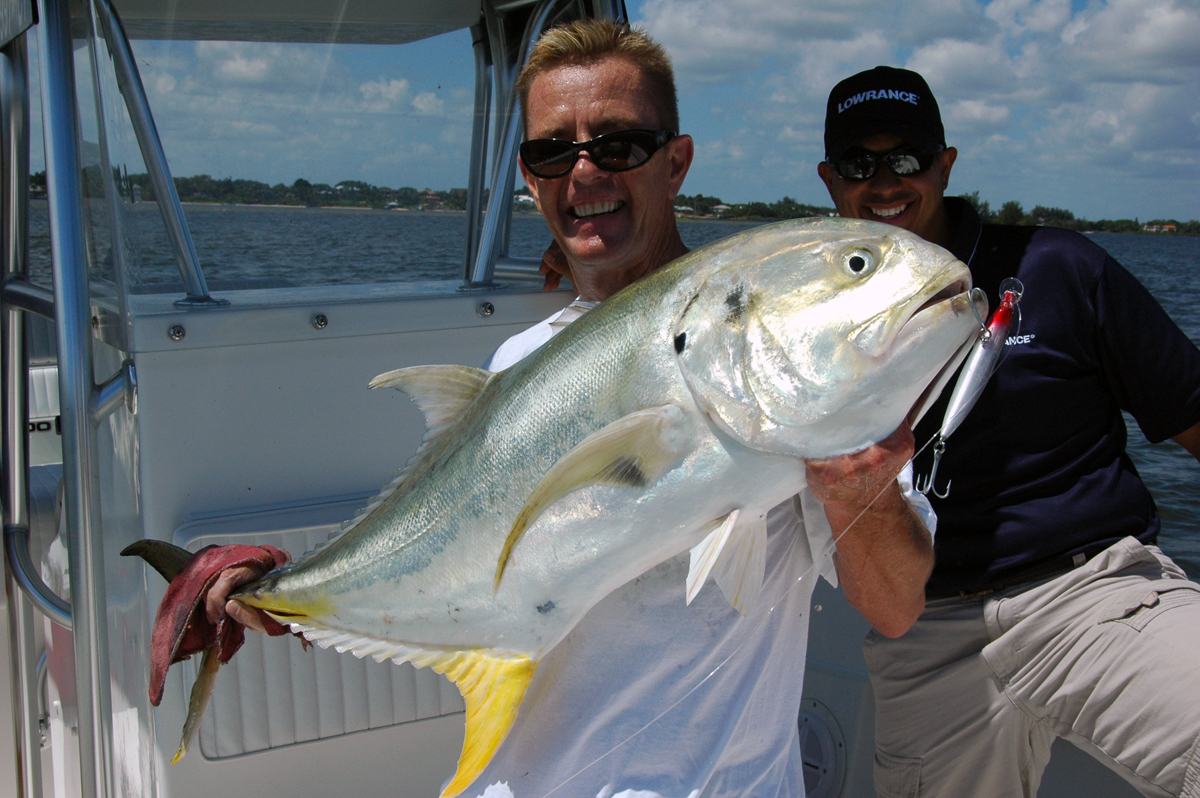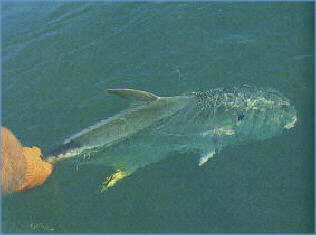July 12, 2016
By Jody Moore

Play your cards right and get jacks to open at the beach.
A huge whirlpool appeared along the shore of Little Gasparilla Island. I turned the boat with the electric trolling motor and headed toward it. A number of big fish were swimming in a nose-to-tail circle--a classic daisy chain. "Tarpon!" I exclaimed. "It's a daisy chain of tarpon."
Atop the poling platform behind me came a voice of midwestern origin. "Nope, looks like jacks to me," said Capt. Denny Blue matter-of-factly.
Jacks? No, couldn't be. As we drew closer, the flicker of silver-sided, platter-shaped fish came into view. I knew permit were known to daisy chain and these fish were big--bigger than most jacks I had caught.
"Permit," I said, admittedly a bit meeker this time.
Blue shook his head. "Definitely jacks," he drawled.
Sure enough, the yellow tails and black spots behind the gill plates were now clearly visible. The captain was right as rain--they were jacks--but their sizes were amazing. These were 25- to 30-pound fish, and there were about 40 of them swimming in a tight circle as they balled a school of glass minnows.
We were within casting range and I took my foot off the trolling motor pedal. I laid out the cast as if presenting a fly to a school of daisy chaining tarpon: the fly landed at the side of the chain and I stripped it. The fly moved in the same direction the fish were moving.
Nothing. My fly was completely ignored. Another cast using the same tactic failed to even get a glance. By now, the boat was in danger of drifting over the school and I feared I would spook them. In a desperate and final attempt, I slapped the fly into the middle of the chain and stripped. A large fish broke rank and turned to track it, and the rest of the school followed.

This hefty jack battled Steve Kantner to his knees. Or is he simply praying that the fast action never stops? |
It was not an extraordinary take, but it was a take. The jack sipped the fly with little fanfare. The next strip indicated tension and I struck hard and applied maximum pressure. With the speed and the power of a fast-attack submarine, he disappeared into the distance.
If my fly reel had a click drag it would have been screaming, but no one would have heard it over my hooting and hollering. The backing quickly peeled off the reel and ripped through the guides, and then it abruptly went slack. I reeled in the slack with a frown, but saw a large jack swim under the boat with a fly line in tow. My eyes bugged out at the realization that I was still hooked up. I took up line furiously until the slack was gone--I was back in the fight.
Forty minutes later we had the fish boatside, but as anyone who has tussled with a large jack crevalle knows, they never give up easily. Add to that the fact that an 8-weight rod is a tough match against 25 pounds of a determined fish with perpetual forward motion, and you have a standoff of considerable magnitude. Every time Capt. Blue reached for the base of the tail, the fish found the extra energy to pull several yards out of reach. The final 10 minutes was spent in vain attempts to land the tireless jack, but finally Blue's gloved hand firmly grasped his tail. A few quick photos later, the fish was released.
Big jack crevalles along Florida's southwest coast are the most underrated light tackle sight casting fish out there. Tarpon and snook get top billing, of course, but a tail-to-tail struggle between a 20-pound snook or tarpon versus a likesize jack would be most interesting.
From late March or early April, extremely large jack crevalles begin to show up in great numbers along the beaches from Sanibel Island up to Manasota Key and beyond. When water temperatures exceed 72 degrees, jacks show up, particularly when there are schools of glass minnows, threadfin herring, Spanish sardines and pilchards. This generally takes place about four or five weeks before snook and tarpon make their debut along the same stretch of shoreline. This push of crevalles will last through July.
All through spring and most of summer, jacks take a back seat to tarpon. A jack battle is usually either an incidental catch or a consolation when fishing is slow. However, they deserve to be a premier target, especially for fly rodders. Much like permit--their relative--jacks fight exceedingly hard and long, but are far more willing to take a fly.
Hordes of large jacks are typically sighted off the beach from the first swash channel about 20 yards out to a half-mile or more offshore. Most of these surf bullies are in the 8- to 10-pound class, with many fish exceeding 30 pounds. Fish swimming at a fast clip are generally on the prowl, searching for food as they swim parallel to the beach. These fish feed in the typical jack fashion: smashing and churning the surface as they race through and beat up bait. Conversely, slow-moving schools of jacks are not prone to eat and will frequently ignore even well-presented baits.
Although some jacks are often taken from schools that patrol the beaches, the best eaters are the ones found daisy chaining. Daisy chainers are definitely feeding, since they are usually balling bait in a tight circle. Often mistaken for tarpon, daisy chains of jacks are not always obvious from the distance. Chaining fish are not crashing the surface, and instead are feeding beneath the surface as they dart in and out of a school of balled up baitfish.

An exhausted jack is revived for release. |
A few telltale signs will alert you to a daisy chain. Watch for seabirds flying and diving in a concentrated area. This activity typically indicates a pack of chaining jacks is feeding below the birds. When waters are calm, watch for nervous baitfish dimpling the surface or bait flipping out of the water in a confined area.
I keep an eye out for circular cloud shadows on the water, which are most likely a ball of jacks just below the surface. Swirling water with tails poking above the surface is another indicator of daisy chaining jacks.
Daisy chains can occur throughout the day, but mornings are most prolific. I've found this to be true if windy or calm.
Just about any lure, jig, spoon or fly that imitates the prevalent bait in the area will get eaten when thrown into the middle of a daisy chain. The strike is nothing spectacular, but the fight certainly is. Any live
bait such as finger mullet, threadfin herring or whitebait caught locally will certainly work. Chartreuse 1/4-ounce bucktail jigs, or jigs with a dark-green grubtail, are proven favorites. Small flies in chartreuse and white with lots of flash such as Clouser Minnows, Deceivers and 3-D's (see Sportsman's Seminar, Dec. '95) are also preferred.
I've found that tarpon flies don't work very well. These are often cast to jacks on a moment's notice while waiting for silver kings to appear. Therefore, even if tarpon hunting, take along a lighter fly rod such as a 9- or 10-weight, rigged with the proper fly. A 40-pound bite leader should deter cutoffs.
Capt. Mike Rehr relates a story about an angler who chartered him during the height of tarpon season. They happened across a daisy chain of jacks. As a diversion it was suggested to the angler that he throw a baitfish fly into the school. A hookup and a 40-minute fight ensued, much to their delight. When the fish was released, the angler said he wanted to go after more jacks and forget about the tarpon fishing.
Capt. Phil O'Bannon finds big jacks not too far from the beaches. He frequently finds jacks in the 8- to 15-pound class and up to 40 pounds along the shorelines and deep canals of the mouth of the Caloosahatchee. Incoming or outgoing tide doesn't seem to matter to these fish, as long as it is running fairly swift. Captiva Pass is another area where oversize jacks are found crashing bait.
Commercial gill netters had hit jack populations hard in recent years, mainly taking smaller ones as the stocks dwindled. Now, although their numbers still aren't what they used to be, jacks are coming back strong after the net ban of nearly three years ago.
So take a shot at some monster jacks along the beaches of southwest Florida, and release them carefully. You just might switch the crosshairs from snook and tarpon to jacks--considering the number of anglers who have discovered the thrill of sight fishing for big jacks.
FS
Florida Sportsman Classics from April, 1998.
Click Here to Have Florida Sportsman Magazine Delivered to Your Home.

